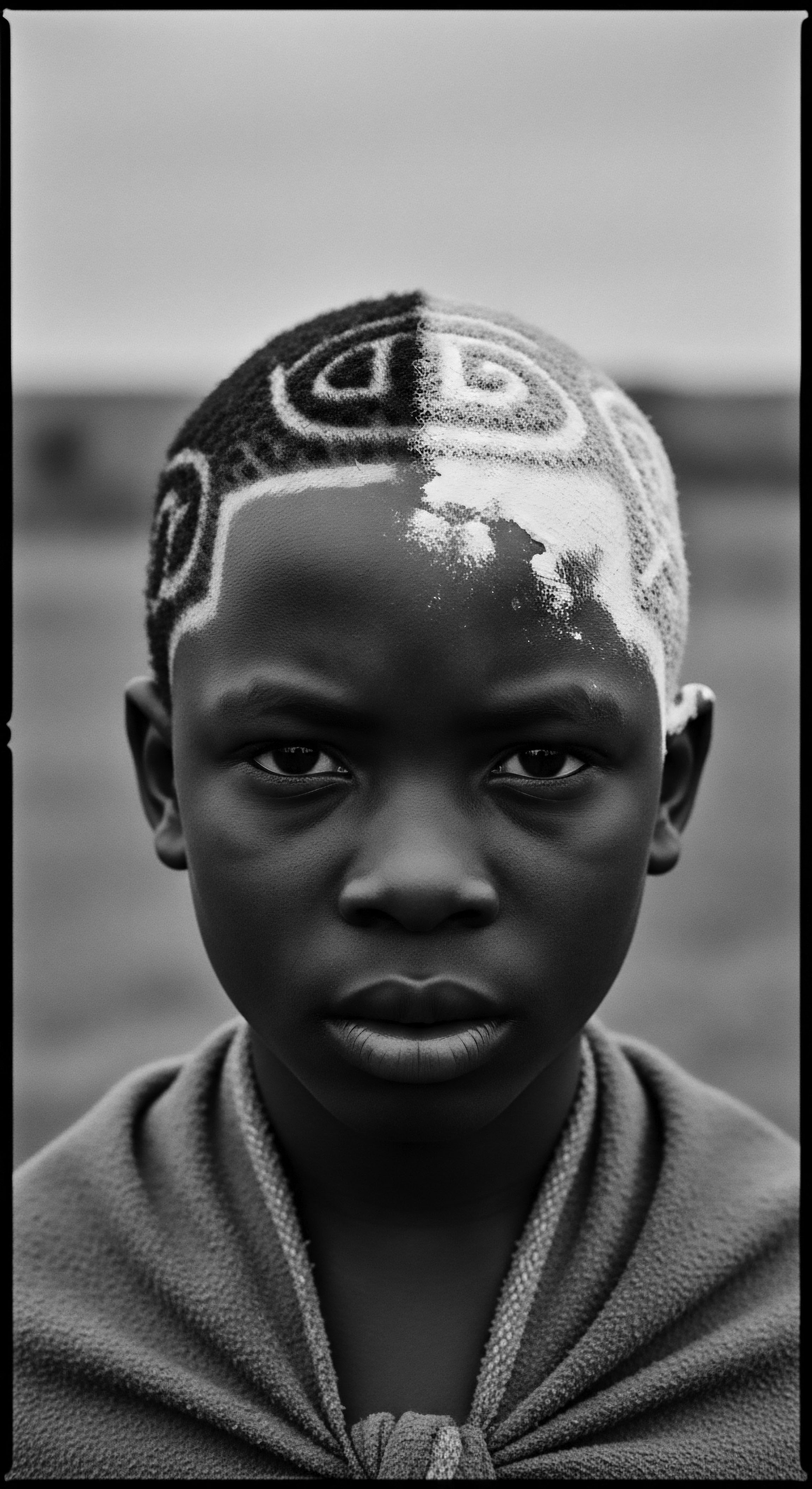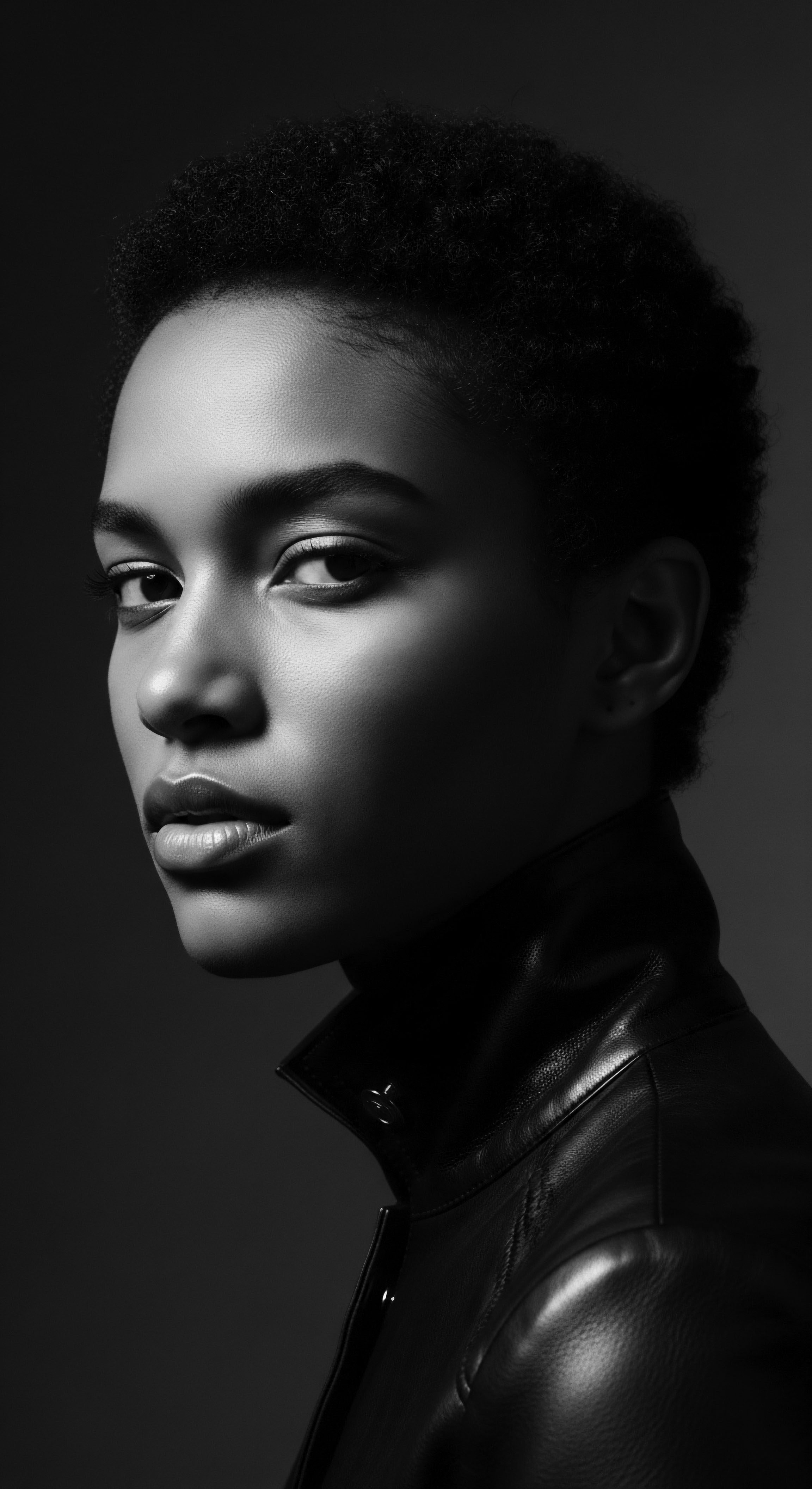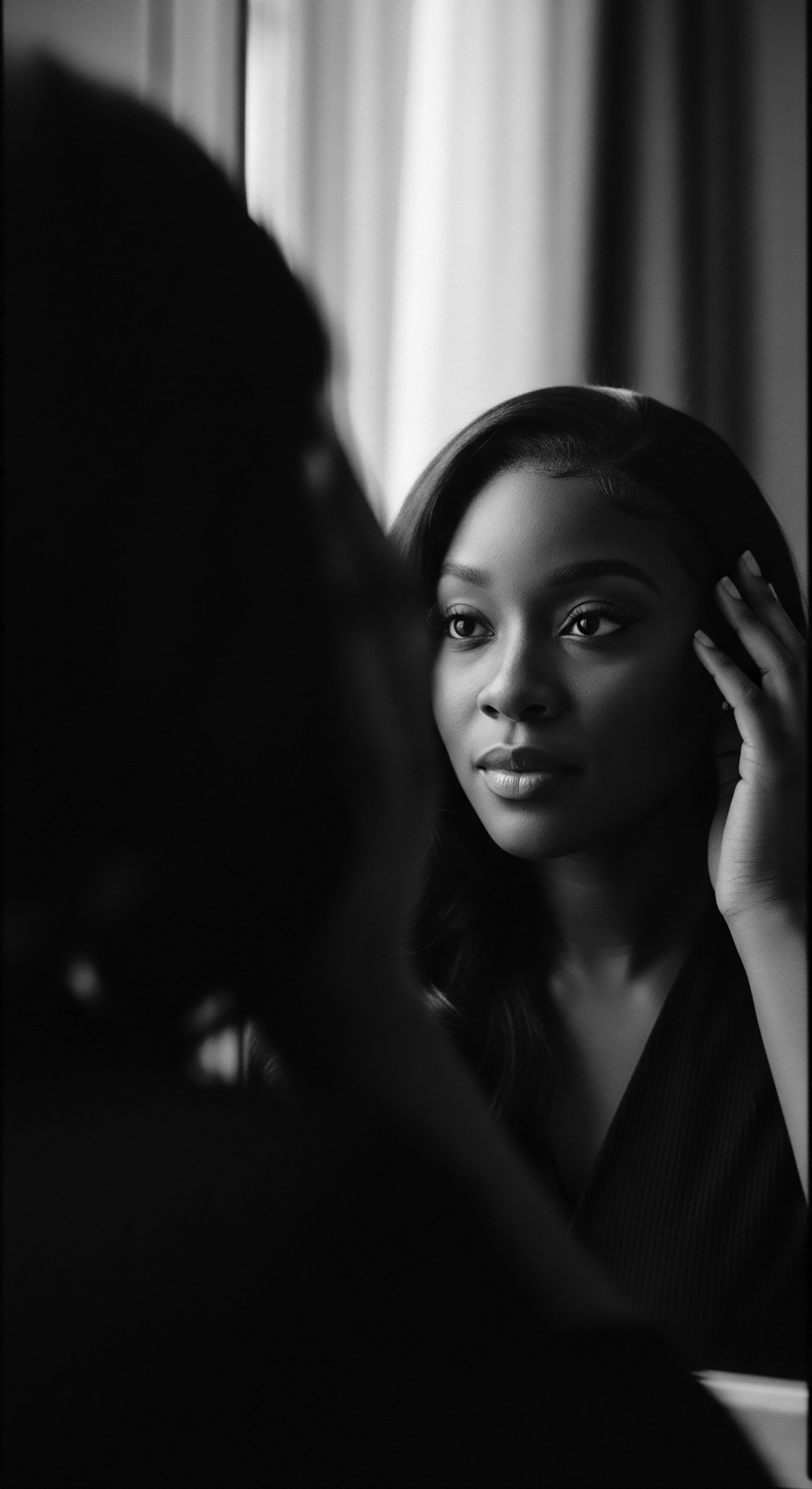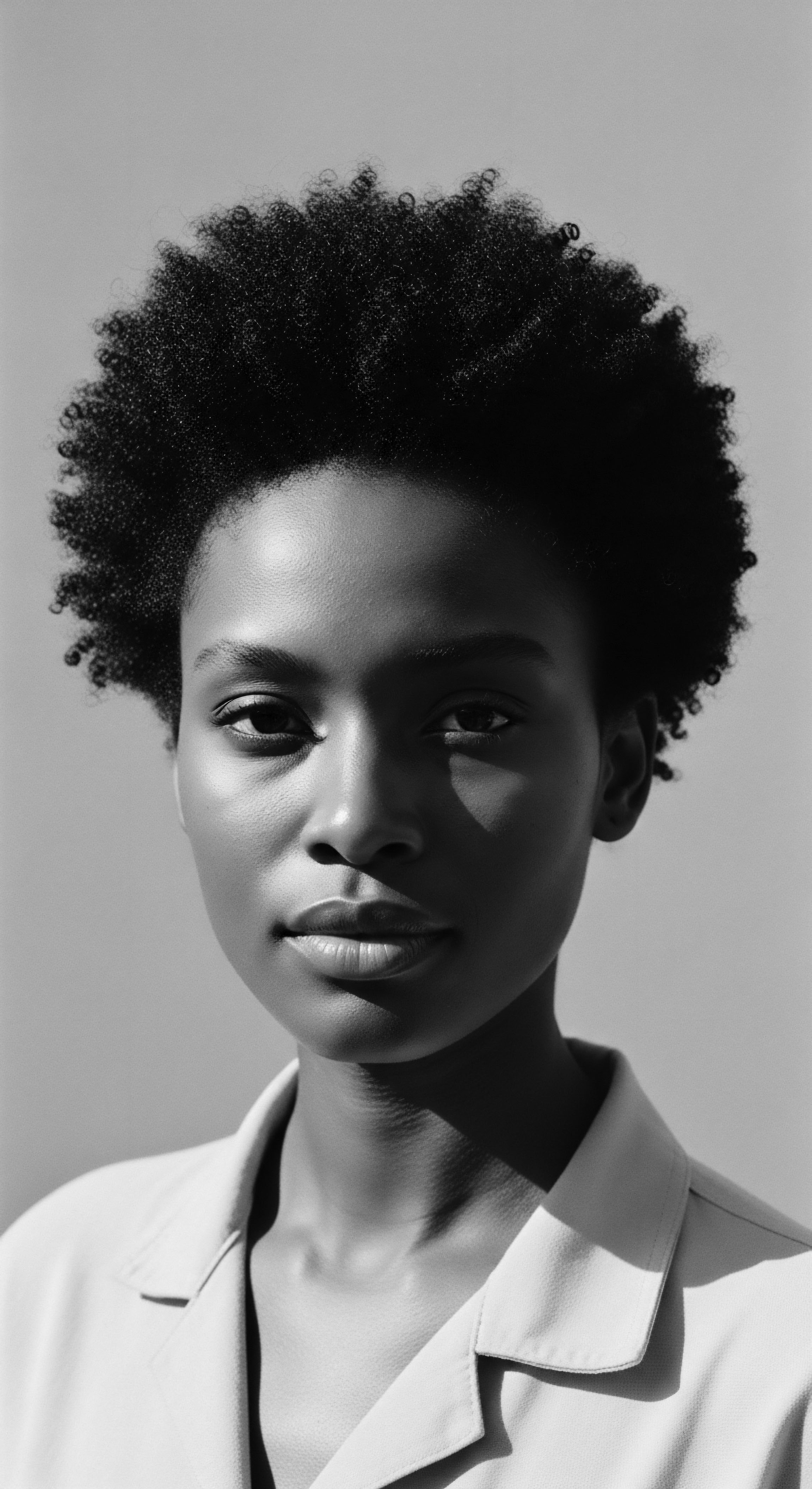
Fundamentals
Hair Biology Resilience, at its most elemental, speaks to the innate capacity of each strand to endure, recover, and sustain its integrity amidst the various forces that seek to diminish it. This intrinsic strength is not a mere accident of nature; it is a profound testament to the deep, often unseen, wisdom encoded within our very being, passed down through the ages. For individuals with textured hair, particularly those within Black and mixed-race communities, this concept extends far beyond basic biological functions. It becomes a reflection of a collective ancestral fortitude, a living legacy manifested in the very fibers that crown our heads.
Consider the foundational components of a single hair strand ❉ the outermost cuticle, a protective layer akin to shingles on a roof; the robust cortex, which provides strength and elasticity; and the innermost medulla, a core that contributes to hair’s overall structure. In textured hair, these components possess unique configurations. The cuticle layers, for instance, may be more prone to lifting due to the curvilinear path of the hair shaft, which can affect moisture retention.
However, the inherent helical structure of textured hair, stemming from its follicular shape, also contributes to a spring-like memory, allowing strands to bounce back from deformation. This dynamic interplay of elements determines hair’s ability to resist breakage, maintain its shape, and retain vital moisture.
Ancestral practices, often developed intuitively through generations of observation and tradition, have long understood these nuances of hair. Long before microscopes revealed the intricate details of the hair shaft, communities recognized the signs of strong, vibrant hair and devised methods to uphold its vitality. These practices were rooted in deep reverence for the hair, viewing it not simply as an appendage, but as a spiritual conduit, a marker of identity, and a repository of history. The definition of hair resilience, therefore, cannot be separated from these historical dimensions, for they shaped the very care rituals that preserved hair’s integrity.
Hair Biology Resilience is the inherent capacity of each strand to endure and recover, a reflection of deep ancestral fortitude within textured hair communities.

Elemental Architecture of Hair Resilience
The physical makeup of textured hair presents both challenges and unique strengths regarding its resilience. The elliptical shape of the follicle, typical of coily and curly strands, dictates a particular growth pattern that leads to the hair’s characteristic bends and curves. These curves create points where the cuticle might be more exposed or prone to friction, potentially increasing vulnerability to damage.
Yet, this very architecture also confers a remarkable capacity for volume and protective styling. The inherent flexibility and coil memory mean that styled hair can return to its natural state, showcasing its robust, intrinsic spring.
- Cuticle Integrity ❉ The outermost protective layer, often more raised in textured hair due to its curvature, requires gentle handling and specific conditioning to remain smooth and closed, shielding the cortex.
- Cortex Strength ❉ The central protein-rich region provides the hair’s primary strength and elasticity. Its organized bundles of keratin, while strong, can be stressed by harsh chemical treatments or excessive heat, leading to diminished resilience.
- Moisture Balance ❉ Textured hair’s unique structure can make it prone to dryness, as natural oils from the scalp might not easily travel down the entire length of the coiled strand. Optimal hydration is central to maintaining suppleness and preventing breakage, thereby enhancing overall resilience.

Echoes from Ancient Wisdom
Understanding hair resilience from a foundational standpoint also involves recognizing the historical continuity of care. Generations past instinctively knew that certain ingredients and practices supported hair’s endurance. Oils pressed from local flora, rich butters, and naturally cleansing clays were not merely cosmetic additions; they were integral to preserving hair’s structural components and shielding it from environmental rigors.
These ancestral methods often focused on maintaining the hair’s natural state, honoring its inherent characteristics rather than attempting to alter them fundamentally. This approach fostered a profound understanding of hair as a living, responding entity, capable of great resilience when treated with reverence.
| Traditional Ingredient Shea Butter (Vitellaria paradoxa) |
| Ancestral Application for Hair Lubricant for styling, scalp massage, pre-shampoo treatment. |
| Link to Hair Biology Resilience Seals in moisture, softens the cuticle, reduces friction and breakage. |
| Traditional Ingredient Palm Oil (Elaeis guineensis) |
| Ancestral Application for Hair Used as a conditioner, emollient, and scalp protector. |
| Link to Hair Biology Resilience Rich in vitamins and fatty acids, provides deep conditioning and environmental barrier. |
| Traditional Ingredient Chebe Powder (from Croton zambesicus) |
| Ancestral Application for Hair Mixed with oils, applied to hair strands for length retention. |
| Link to Hair Biology Resilience Creates a protective coating, minimizing mechanical stress and moisture loss, thereby enhancing strand strength over time. |
| Traditional Ingredient These ancestral ingredients reflect a deep knowledge of natural elements that inherently supported hair's endurance and vitality. |

Intermediate
Moving beyond the basic framework, Hair Biology Resilience represents a dynamic interplay of intrinsic biological attributes and external protective measures, particularly pronounced in the story of textured hair. This intermediate understanding delves into the specific biophysical properties that grant coiled and curly strands their remarkable strength, alongside the historical care strategies that communities of African descent developed to uphold and fortify this inherent endurance. The Hair Biology Resilience of textured hair is not a singular trait; it is a symphony of interconnected factors, each contributing to the hair’s ability to withstand repeated manipulation, environmental shifts, and even the pressures of cultural assimilation.
The unique helical structure of textured hair strands means that forces applied to the hair are distributed differently along its axis compared to straight hair. While its many bends can create points of vulnerability if not properly moisturized and handled, these very curves also provide an elasticity that allows the hair to compress and stretch without immediately fracturing. This inherent springiness is a biological asset, a physical characteristic that, when supported by mindful care, contributes significantly to the hair’s capacity to return to its original form after being pulled or styled. The hair’s natural coil acts as a shock absorber, a subtle yet powerful mechanism of self-preservation.
Hair Biology Resilience in textured hair is a dynamic interplay of inherent biophysical properties and ancestral care strategies, fortifying its strength against various challenges.

Adaptive Mechanisms in Textured Hair
The biological composition of textured hair provides several adaptive mechanisms that contribute to its resilience. The distribution of melanin, for instance, can affect the hair’s mechanical properties, offering some degree of natural protection against ultraviolet radiation. The intricate network of disulfide bonds within the cortex, responsible for holding the keratin proteins together, is a significant determinant of hair strength and curl pattern. While external factors can disrupt these bonds, leading to damage, traditional practices often employed ingredients that implicitly supported their integrity or aided in their recovery.
Consider the variations in cuticle density and orientation along the spiral of a textured hair strand. These variations influence how moisture enters and leaves the hair, highlighting the importance of humectants and emollients in historical care rituals. Communities in diverse regions understood that maintaining optimal moisture levels was paramount for preventing brittleness and maintaining suppleness. They utilized local plant-based emollients, not merely for cosmetic shine, but as practical agents for keeping the hair hydrated and flexible, directly bolstering its physical resilience against breakage.

The Legacy of Protective Styling
The continuum of Hair Biology Resilience is inseparable from the history of protective styling within African and diasporic communities. These styles were not merely aesthetic choices; they were intentional strategies to shield the hair from breakage, environmental damage, and daily friction. Braids, twists, cornrows, and various forms of intricate coiling served to bundle individual strands together, reducing tangling and minimizing exposure to external stressors. This practice speaks to an intuitive understanding of hair physics, wherein collective strength surpasses that of isolated components.
The ingenuity evident in these traditional styling methods reveals a sophisticated, embodied knowledge of hair care. Women and men meticulously crafted styles that allowed hair to rest, grow, and retain moisture, preserving its strength over extended periods. This was particularly crucial in environments where daily manipulation or harsh climatic conditions could otherwise compromise hair health. The very act of creating and maintaining these styles became a ritual of care, passed down through generations, thereby embedding the concept of hair resilience within the social fabric of communities.
- Cornrows ❉ A close-to-scalp braiding technique that minimizes tension on individual strands, protecting the length and ends from exposure and manipulation. This method, historically a form of communication and communal artistry, allowed hair to grow undisturbed for extended periods.
- Twists ❉ Two-strand twists or flat twists encapsulate hair, preserving moisture and reducing tangling. They offer a gentle alternative to braids, allowing for greater flexibility and ease of detangling.
- Bantu Knots ❉ A protective coiling method where sections of hair are twisted until they coil into themselves, forming small knots. This practice protects the ends of the hair, which are often the oldest and most fragile parts, from friction and environmental elements.

Academic
Hair Biology Resilience, viewed through an academic lens, encapsulates the complex interplay of genetic predispositions, the unique biomechanical properties of the hair shaft, and the profound influence of historical and cultural adaptive practices, especially within communities with highly textured hair. This concept delineates the hair’s ability to resist degradation, recover from mechanical and chemical stresses, and maintain its structural and aesthetic integrity over time. For Black and mixed-race hair, this deeper understanding moves beyond a purely physiological definition to acknowledge the layered historical contexts that have shaped both the hair’s biological realities and the ancestral knowledge systems developed to safeguard it.
The genetic underpinnings of textured hair contribute significantly to its distinct morphology. Variations in genes such as EDAR, FGFR2, and TCHH influence the shape of the hair follicle, which in turn dictates the curvature of the hair strand. A more elliptical or asymmetrical follicular opening results in coiled or wavy hair, affecting how keratin proteins are packed and how disulfide bonds form within the cortex.
This structural reality means textured hair often presents more points of natural bend and twist, which, while providing unparalleled volume and style versatility, can also render it more susceptible to breakage under specific conditions of mechanical stress or inadequate moisture. The hair’s elasticity, its capacity to stretch and return to its original form, is a direct measure of this biomechanical resilience.
Hair Biology Resilience, in academic discourse, marries genetic predispositions, biomechanical properties, and historical adaptive practices, revealing the layered endurance of textured hair.

The Biomechanical Reality of Textured Hair
The unique architecture of textured hair, with its diverse curl patterns from loose waves to tight coils, means that forces applied to the hair are distributed unevenly. The cuticle, the hair’s outermost protective layer, tends to be more lifted at the curves of a coiled strand compared to straight hair. This characteristic impacts how the hair interacts with moisture, making it prone to dryness as the natural sebum produced by the scalp may not easily traverse the entire length of a tightly coiled strand. Consequently, the Hair Biology Resilience of textured hair is profoundly linked to its hydration status.
A well-hydrated strand maintains its suppleness, allowing the cuticle to lay flatter and the cortex to remain flexible, thereby reducing friction and susceptibility to fracture. Scientific studies now affirm the importance of emollients and humectants in mitigating this dryness, a validation of age-old practices that intuitively relied on rich natural oils and butters for hair maintenance.
Furthermore, the density and distribution of disulfide bonds within the keratin structure play a critical role. While all hair types possess these bonds, their specific arrangement in textured hair contributes to its unique spring and resilience. Disruption of these bonds through harsh chemical treatments, such as relaxers or strong dyes, directly compromises the Hair Biology Resilience, leading to increased breakage and altered texture. The hair’s capacity to absorb and retain water, known as its porosity, is also a significant factor; highly porous hair, often a result of damaged cuticles, absorbs water quickly but struggles to retain it, necessitating particular care strategies to rebuild its protective barriers and restore its resilience.

Ancestral Ingenuity and Embodied Resistance
The most compelling academic exploration of Hair Biology Resilience, particularly for Black and mixed-race hair, must acknowledge its profound connection to historical adversity and resistance. During the transatlantic slave trade, enslavers frequently shaved the heads of captured Africans upon arrival, a deliberate act to strip identity and communal connection. However, the innate human spirit, mirrored by the hair’s remarkable capacity for renewal, found ways to subvert these dehumanizing efforts. Hair became a covert canvas for survival, a testament to an enduring spirit.
One potent, rigorously documented historical example of Hair Biology Resilience as both biological and cultural survival lies in the ingenious use of Cornrows by Enslaved Africans to Map Escape Routes and Conceal Vital Provisions. As detailed in historical accounts and oral traditions from various parts of the Americas, including Colombia, these intricate styles served as clandestine guides to freedom. For instance, the tight, close-to-scalp patterns of cornrows could depict topographical features like mountains, rivers, or trails, charting paths through unfamiliar and hostile terrain.
Beyond spatial mapping, these braided styles also served as secret receptacles. Seeds, precious grains of rice, or even small gold nuggets were often hidden within the cornrows, providing sustenance or currency for those attempting to flee bondage. This practice exemplifies resilience on multiple levels ❉ the hair’s physical ability to hold these items without revealing them, the communal trust and knowledge required to interpret these living maps, and the profound psychological fortitude of individuals using their bodies and traditions as tools of liberation.
This specific historical reality underscores that Hair Biology Resilience is not a static biological definition; it is a dynamic, evolving concept shaped by generations of struggle, adaptation, and profound ingenuity. It highlights how the act of hair care, often dismissed as superficial, was in fact a site of profound resistance and the preservation of life itself.

Ethnobotanical Wisdom and Hair Fortification
Traditional African hair care practices offer a wealth of knowledge concerning the Hair Biology Resilience. Ethnobotanical studies reveal a long history of utilizing local flora for their protective and nourishing properties. These practices were often holistic, recognizing that scalp health directly influenced hair strength.
Ingredients such as shea butter, palm oil, and various plant extracts were employed not simply as conditioners but as agents that contributed to the overall structural integrity of the hair strand. They provided natural moisture, created protective barriers against environmental elements, and supplied essential nutrients that supported keratin health.
For instance, the application of certain plant-based oils and butters formed a physical shield around the hair shaft, mitigating the drying effects of sun and wind, and reducing mechanical damage from daily activities. This foresight, born from observation and passed through oral traditions, anticipated modern scientific understanding of lipid layers and cuticle protection. The continuity of these practices, even through immense societal upheaval, speaks to their efficacy and deep cultural significance in maintaining hair’s biological endurance.
- Hair Follicle Shape ❉ An elliptical or flattened follicle shape dictates the hair’s coiled growth pattern, impacting how sebum is distributed along the strand.
- Disulfide Bond Distribution ❉ The specific arrangement of these bonds within the keratin structure determines the hair’s rigidity and curl, directly influencing its strength and elasticity.
- Cuticle Response ❉ The outermost layer of scales on the hair shaft lifts and flattens in response to environmental conditions and product pH, influencing moisture retention and overall strand protection.
| Traditional Practice Sealing with Natural Butters/Oils |
| Cultural/Historical Context Common in West African and Caribbean traditions for daily moisture. |
| Biological Rationale for Resilience Creates an occlusive layer that slows water evaporation from the hair shaft, keeping the cortex hydrated and flexible, reducing brittleness and breakage. |
| Traditional Practice Regular Cleansing with Clays/Herbs |
| Cultural/Historical Context Used across various African cultures for purification and scalp health. |
| Biological Rationale for Resilience Gently removes impurities and product buildup without stripping natural oils, maintaining a balanced scalp microbiome conducive to healthy hair growth and preventing follicle blockage. |
| Traditional Practice Detangling with Fingers/Wide-Tooth Tools |
| Cultural/Historical Context A careful, patient process often part of communal grooming rituals. |
| Biological Rationale for Resilience Minimizes mechanical stress on fragile wet strands, reducing snags and tears that lead to cuticle damage and breakage, preserving hair length and density. |
| Traditional Practice These ancestral methodologies were deeply rooted in an intuitive understanding of hair's needs, often validated by contemporary scientific inquiry into Hair Biology Resilience. |

Reflection on the Heritage of Hair Biology Resilience
The journey into Hair Biology Resilience, particularly through the storied landscape of textured hair, leads us to a profound understanding ❉ that the very concept is steeped in a legacy far older and richer than scientific definition alone can convey. It is a concept that breathes with the memories of hands that braided defiance into strands, of communities that whispered remedies across generations, and of spirits that refused to be diminished, even when faced with the most formidable trials. This resilience is not simply a biological trait; it is a cultural artifact, a living archive inscribed within each coil and curl, bearing witness to a heritage of unwavering strength.
To truly comprehend Hair Biology Resilience is to acknowledge the enduring soul held within each strand. This enduring quality speaks to the deep connection between physical manifestation and spiritual perseverance. It reminds us that care for textured hair is more than a regimen; it is an act of honoring ancestry, a quiet rebellion against historical attempts to devalue Black and mixed-race hair. The wisdom gleaned from centuries of protective styles and natural ingredients affirms a holistic approach, one where the well-being of the hair is intrinsically linked to the well-being of the individual and their place within a vibrant cultural lineage.
Hair Biology Resilience is a living archive within each coil, reflecting generations of unwavering strength and a cultural heritage of perseverance.
This perspective encourages us to view our textured hair not as something to be tamed or altered to fit narrow ideals, but as a crown of inherited fortitude. It invites a re-discovery of practices that have always sought to nourish and protect, celebrating the hair’s natural inclinations rather than working against them. As we continue to unravel the complexities of hair science, we consistently find echoes of ancestral wisdom, often validating the intuitive understanding of those who came before us. The Hair Biology Resilience, in this light, becomes a bridge connecting our present understanding to the deep well of the past, encouraging a future where textured hair is universally recognized for its inherent beauty and enduring strength, a vibrant testament to an unbroken lineage.

References
- Matjila, Chéri R. The Meaning of Hair for Southern African Black Women. University of the Free State, 2020.
- Fashola, Joseph O. and Hannah Abiodun. The Ontology of Hair and Identity Crises in African Literature. PhilArchive, 2023.
- Sieber, Roy, and Frank Herreman. Hair in African Art and Culture. Museum for African Art, 2000.
- Akanmori, Ebenezer. The Impact of Hair Discrimination on Black Women in the Workplace. University of California, Berkeley, 2015.
- Byrd, Ayana D. and Lori L. Tharps. Hair Story ❉ Untangling the Roots of Black Hair in America. St. Martin’s Press, 2001.
- Randle, Stephanie. “Hair as a Weapon ❉ Hair as a Form of Resistance.” In Black Women’s Hair, edited by Kimberly C. Williams and Lori L. Tharps. Rutgers University Press, 2015.
- Mbilishaka, Noliwe, et al. “The Psychology of Black Hair ❉ Unveiling the Social, Cultural, and Personal Impact of Hair on Black Women.” Journal of Black Psychology, 2020.
- Thomas, Valerie J. “Hair, Culture, and Identity ❉ A Black Perspective.” Journal of Black Studies, 2013.
- Penelope, James, and David F. Tinsley. “Cosmetopoeia of African Plants in Hair Treatment and Care ❉ Topical Nutrition and the Antidiabetic Connection?” Diversity, vol. 16, no. 2, 2024, p. 96.
- Penniman, Leah. Farming While Black ❉ Soul Fire Farm’s Practical Guide to Liberation on the Land. Chelsea Green Publishing, 2020.
